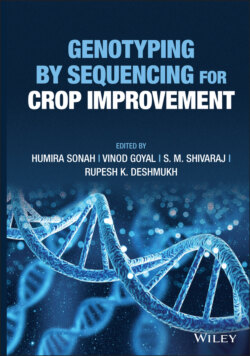Читать книгу Genotyping by Sequencing for Crop Improvement - Группа авторов - Страница 67
3.4 Whole‐Genome Pooled Sequencing
ОглавлениеGenotyping populations with NGS technologies are very convenient and appealing (Unamba et al. 2015). Whole‐genome pooled sequencing popularly known as Pool‐seq has been used to sequence multiple individuals instead of single individuals from a population separately (Fracassetti et al. 2015). The main advantage is that large number of samples can be assayed in a cost‐effective manner. But sometimes, pooling is necessary when separating individuals is difficult and when sufficient DNA is not there to create individual libraries. Pooling is used for the estimation of SNP frequencies in population genetics. Pooling approach has been applied to study genetic loci governing a trait, to perform GWAS (Bastide et al. 2013), and to gather demographic history of population (Hellwege et al. 2017). During statistical analysis, random experimental errors in measuring allele frequencies from pooled DNA should be considered. Sophisticated pooling designs are being developed in order to take care of hidden population stratification, confounders, and interactions, allowing the analysis of haplotypes (Sham et al. 2002; Norton et al. 2004). Fracassetti et al. (2015) verified a pooled whole‐genome resequencing (Pool‐seq) technique on Arabidopsis lyrata in which only 1.6 ng DNA per individual was used for library preparation. They compared the SNP frequencies, acquired by pooling to those generated by individual‐based genotyping‐by‐sequencing (GBS), and found, Pool‐seq as a viable approach for obtaining population‐level SNP frequency data with good accuracy in a larger number of samples. They also examined the effects of sample size, sequencing depth per individual, and variant caller on population SNP frequency estimations. Since differential amplification occurs for many SNPs, and this biasness should be rectified during the estimation of allele frequency from pooled DNA (Sham et al. 2002; Norton et al. 2004). Whole‐genome sequencing of pooled F2 individuals has been used to identify mapping interval and candidate gene SNPs in maize (Klein et al. 2018).
NGS technique in combination with whole‐genome shotgun sequencing can be used to genotype nonmutant Vs. mutant bulked segregant analysis (BSA) pools at markers across the genome (Klein et al. 2018). With the advent of NGS, even without precise mapping, BSA may be utilized to immediately identify a very narrow mapping interval, causative lesion, and so forth. The genomic interval containing the mutant gene of interest can be discovered using BSA‐Seq data (Hill et al. 2013). In a pooled BSA sample, the unlinked marker will be genotypically heterozygous, unless F1 recombination has occurred between the mutant lesion and a specific marker, while the linked markers will be homozygous for the mutant parent genotype. BSA‐Seq is a useful approach for genome reduction that allows to increase sequencing depth without raising costs.
